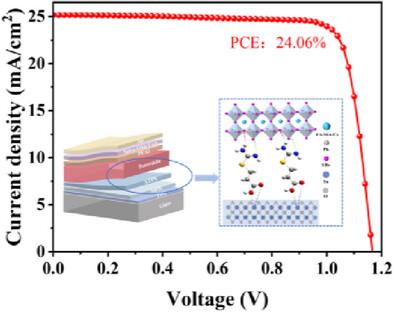Achieving Defect Passivation and Oriented Crystallization Regulation at the SnO2/Perovskite Interface via Molecular Bridging
IF 12.1
2区 材料科学
Q1 CHEMISTRY, MULTIDISCIPLINARY
引用次数: 0
Abstract
Buried interface defects between the SnO2 electron transport layer (ETL) and the perovskite layer severely limit the efficiency, hysteresis, and stability of SnO2-based perovskite solar cells (PSCs). In this study, 3-Isothioureidopropionic acid (ATPN) is introduced as a molecular bridge at the buried perovskite interface, effectively passivating interface defects and regulating the oriented growth of perovskite crystals. The carboxyl (-COOH) groups of ATPN passivate dangling Sn bonds on SnO2, reducing surface oxygen vacancies and facilitating charge extraction and transport. Meanwhile, the imino (-C═NH) and amino (-NH2) groups of ATPN effectively passivate undercoordinated Pb2+ and I− ions in the perovskite, reducing interfacial defects and optimizing energy level alignment. In situ crystallization studies reveal that ATPN-mediated modulation extends the recrystallization process of the perovskite, promoting the formation of larger grains during fabrication. Additionally, this strategy induces a highly preferred out-of-plane (100) crystal orientation by eliminating energy barriers, thus enhancing carrier extraction and transport. A champion ATPN-treated PSC achieved a power conversion efficiency (PCE) of 24.06%, compared to 22.15% for the control device. After 1920 h of aging in a nitrogen atmosphere, the ATPN-modified device retained 90.14% of its initial PCE, while the unmodified device retained only 68.32%.

通过分子桥接实现SnO2/钙钛矿界面缺陷钝化和定向结晶调控
SnO2电子传输层(ETL)与钙钛矿层之间的埋藏界面缺陷严重限制了SnO2基钙钛矿太阳能电池(PSCs)的效率、迟滞性和稳定性。在本研究中,3-异硫脲二丙酸(ATPN)作为埋地钙钛矿界面上的分子桥,有效地钝化界面缺陷,调节钙钛矿晶体的定向生长。ATPN的羧基(-COOH)钝化了SnO2上的悬垂Sn键,减少了表面氧空位,促进了电荷的提取和传输。同时,ATPN的亚胺(-C = NH)和氨基(-NH2)基团有效地钝化钙钛矿中缺乏配位的Pb2+和I -离子,减少了界面缺陷并优化了能级排列。原位结晶研究表明,atpn介导的调制延长了钙钛矿的再结晶过程,促进了制备过程中更大晶粒的形成。此外,该策略通过消除能量障碍诱导出高度优选的面外(100)晶体取向,从而增强载流子的提取和输运。经过atpn处理的PSC的功率转换效率(PCE)为24.06%,而控制装置的功率转换效率为22.15%。在氮气气氛中老化1920 h后,经atpn修饰的器件保留了初始PCE的90.14%,而未经修饰的器件仅保留了68.32%。
本文章由计算机程序翻译,如有差异,请以英文原文为准。
求助全文
约1分钟内获得全文
求助全文
来源期刊

Small
工程技术-材料科学:综合
CiteScore
17.70
自引率
3.80%
发文量
1830
审稿时长
2.1 months
期刊介绍:
Small serves as an exceptional platform for both experimental and theoretical studies in fundamental and applied interdisciplinary research at the nano- and microscale. The journal offers a compelling mix of peer-reviewed Research Articles, Reviews, Perspectives, and Comments.
With a remarkable 2022 Journal Impact Factor of 13.3 (Journal Citation Reports from Clarivate Analytics, 2023), Small remains among the top multidisciplinary journals, covering a wide range of topics at the interface of materials science, chemistry, physics, engineering, medicine, and biology.
Small's readership includes biochemists, biologists, biomedical scientists, chemists, engineers, information technologists, materials scientists, physicists, and theoreticians alike.
 求助内容:
求助内容: 应助结果提醒方式:
应助结果提醒方式:


